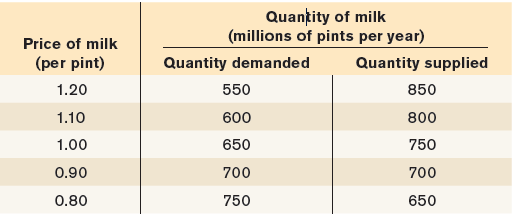The accompanying table shows hypothetical demand and supply schedules for milk per year. The Canadian government decides
Question:

a. How much surplus milk will be produced as a result of this policy?
b. What will be the cost to the government of this policy?
c. Since milk is an important source of protein and calcium, the government decides to provide the surplus milk it purchases to elementary schools at a price of only $0.60 per pint. Assume that schools will buy any amount of milk available at this low price. But parents now reduce their purchases of milk at any price by 50 million pints per year because they know their children are getting milk at school. How much will the dairy program now cost the government?
d. Explain how inefficiencies in the form of inefficient allocation to sellers and wasted resources arise from this policy.
Step by Step Answer:

Macroeconomics
ISBN: 978-1319120054
3rd Canadian edition
Authors: Paul Krugman, Robin Wells, Iris Au, Jack Parkinson





